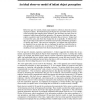Free Online Productivity Tools
i2Speak
i2Symbol
i2OCR
iTex2Img
iWeb2Print
iWeb2Shot
i2Type
iPdf2Split
iPdf2Merge
i2Bopomofo
i2Arabic
i2Style
i2Image
i2PDF
iLatex2Rtf
Sci2ools
NIPS
2008
2008
An ideal observer model of infant object perception
Before the age of 4 months, infants make inductive inferences about the motions of physical objects. Developmental psychologists have provided verbal accounts of the knowledge that supports these inferences, but often these accounts focus on categorical rather than probabilistic principles. We propose that infant object perception is guided in part by probabilistic principles like persistence: things tend to remain the same, and when they change they do so gradually. To illustrate this idea we develop an ideal observer model that incorporates probabilistic principles of rigidity and inertia. Like previous researchers, we suggest that rigid motions are expected from an early age, but we challenge the previous claim that the inertia principle is relatively slow to develop [1]. We support these arguments by modeling several experiments from the developmental literature. Over the past few decades, ingenious experiments [1, 2] have suggested that infants rely on systematic expectations abo...
Information Technology | NIPS 2008 | Object Perception | Physical Objects | Probabilistic Principles |
Related Content
| Added | 29 Oct 2010 |
| Updated | 29 Oct 2010 |
| Type | Conference |
| Year | 2008 |
| Where | NIPS |
| Authors | Charles Kemp, Fei Xu |
Comments (0)

